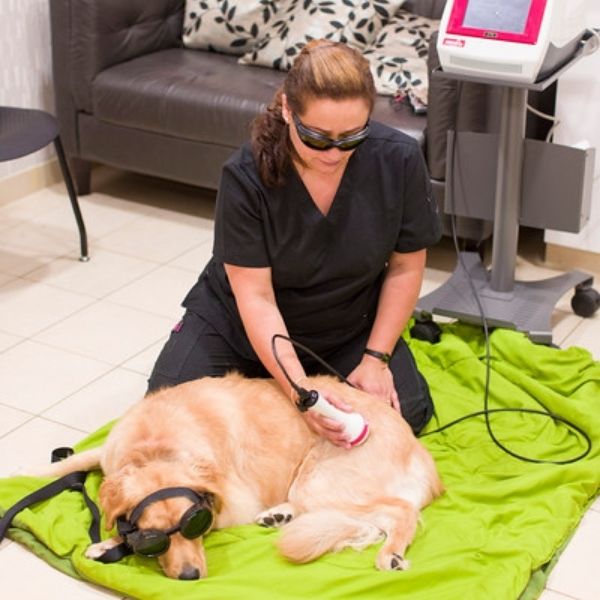Pet Lasery Therapy
Pet Laser Therapy
Laser Therapy also may be referred to as Cold Laser, Low-Level Laser, or Class IV Laser Therapy. Each of these terms refers to the same therapy, using the same equipment. Laser therapy helps to stimulate cell regeneration and increase blood circulation.

Laser Therapy does 3 main things:
- Reduces pain
- Reduces inflammation
- Speeds healing time.
We have had Laser Therapy at the VVC for many years and our patients have greatly benefitted. We use laser therapy on a daily basis with our canine rehabilitation & pain management patients and acupuncture patients, and we have also implemented it into our surgical protocols. All patients receive post-surgical treatments to help with their recovery time.
Laser can be used on acute (quick onset) conditions such as wounds, allergies, infections, cuts/bites, inflammation, tooth extractions, sprains/strains/fractures, post-surgical healing, or even feline lower urinary tract disease or cystitis. It can also be utilized for chronic (long-term) conditions: Degenerative Joint disease, Inflammatory Bowel disease, Periodontal disease, Lick Granulomas, geriatric care, hip dysplasia, feline acne, tendonitis, arthritis, otitis. These conditions are all to, just name a few, are many other uses for the laser.
How does it work?
Laser therapy uses a targeted light (as seen in the photo below) to go deep into your tissues without damaging them and work on your body on a cellular level (yes, we are talking mitochondria… cell biology coming back to you?).

All dogs, cats, and even humans have parts of their cells that produce energy, and when they are stimulated by the light from the laser it causes a change called “photo-bio-modulation”. During that whole process, your body starts to release endorphins, stimulates injured cells to heal and also helps itself to relieve any pain sensations.
It also causes the production of ATP. ATP is the fuel and energy needed by cells for repair and rejuvenation. When cells have been injured they cannot make ATP, which can lead to improper or slow healing or no healing at all. When using the laser, it can stimulate the cells to produce ATP again!

How long do sessions last?
Laser therapies vary in time depending on the area of concern. But we make the experience worthwhile! Everyone is on a nice cushy mat, with lots of comforters. We are in a quiet room (and don’t tell anyone, but treats are constant!). Not to mention everyone is in the cool glasses and doggles (see photos below). The laser light is delivered through a non-invasive handpiece. Your pet may feel some soothing warmth in the area, and depending on the procedure, the handpiece may not even touch your pet at all (if we do need to use the handpiece on your pet, they may feel some soothing warmth on the area and depending on the type of procedure a smooth, soothing ball will massage the area).

When Do You See Improvement?
Although improvement is often seen after the first visit, your dog’s condition will influence how often and long laser therapy is necessary. Cumulative treatments for some conditions are often recommended. Treatments vary in length, but most sites require 2 to 10 minutes. Most laser treatments are cumulative, so each additional treatment facilitates a greater improvement in your dog or cat’s condition. The length and frequency of treatments vary by condition, so allow your veterinarian to help devise a sufficient laser treatment schedule for your four-legged friend.
This can work on its own or in conjunction with other modalities (canine rehabilitation, pain management, or acupuncture for example) and medications. It is all about finding what is going to work best for your pet.
Fun Facts!
Teams in the NHL, NBA, NFL, MLB, MLS, Olympic, and collegiate teams all use this exact laser as part of their therapy!
******** The Buffalo Sabres, Los Angles Lakers, Cleveland Indians, Toronto Blue Jays all own and use this exact laser!

Laser can be used on the following conditions in cats (but not limited to!)
- Acute & chronic otitis
- Gingivitis
- Dental Disease
- Skin infections
- Arthritis
- Degenerative Joint Disease
- Broken Bones
- Post-surgical incisions or post-surgical healing
- Anal Glands
- Rhinitis
- Sinusitis
- Stomatitis
- Cystitis
Laser can be used on the following conditions in dogs (but not limited to!)
- Acute & chronic otitis (ear infections)
- Gingivitis
- Dental Disease
- Hot spots
- Skin infections
- Arthritis
- Lick Granulomas
- Degenerative Joint Disease
- Broken Bones
- Post-surgical incisions or post-surgical healing
- Degenerative disc disease (back injuries)
- Anal Glands
- Hip dysplasia
- Elbow dysplasia
